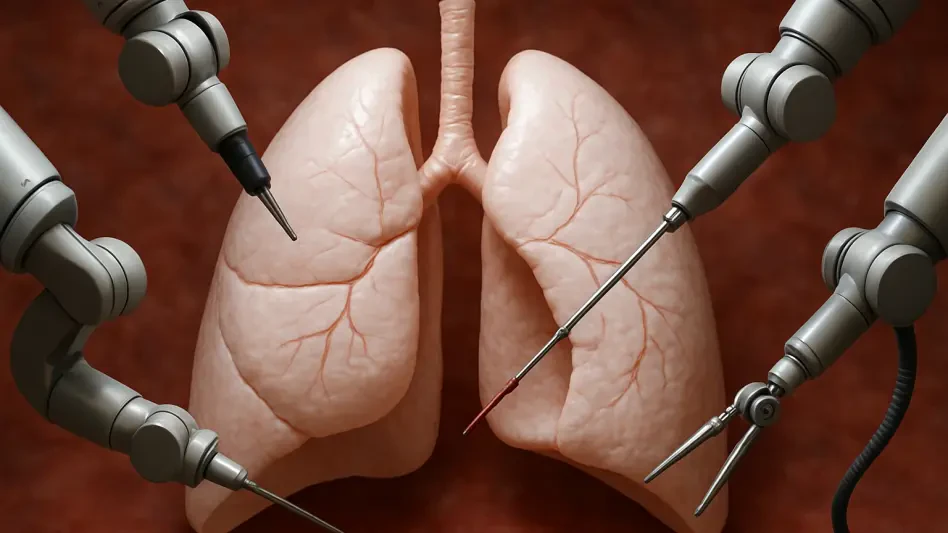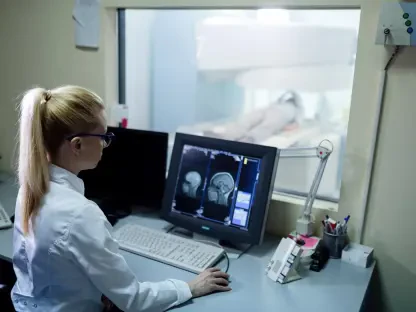In a groundbreaking stride for medical technology, Intuitive Surgical, a trailblazer based in Sunnyvale, California, has unveiled remarkable enhancements to its Ion endoluminal robotic system, recently earning expanded clearance from the FDA. This catheter-based platform, designed for minimally invasive lung biopsies, now integrates cutting-edge artificial intelligence and advanced imaging capabilities, promising to revolutionize diagnostic precision. As lung cancer remains a leading cause of mortality worldwide, the ability to detect and biopsy hard-to-reach nodules with greater accuracy could be a game-changer for early diagnosis and improved patient outcomes. These upgrades address longstanding challenges in the field, offering hope for more effective interventions. With hundreds of systems already deployed globally, the impact of this innovation is poised to reach a wide array of healthcare settings, setting a new standard for robotic-assisted procedures in pulmonology.
Revolutionizing Lung Biopsy Navigation with AI
The centerpiece of the Ion system’s latest software update is an AI-driven navigation enhancement that tackles a critical obstacle in lung biopsies known as CT-to-body divergence. This issue occurs when a nodule’s position shifts during a procedure compared to its location in pre-procedure imaging, often due to natural lung movement. Such discrepancies can complicate accurate targeting, potentially delaying critical diagnoses. The new AI technology merges computer vision with proprietary shape-sensing capabilities to adjust navigation paths in real-time. By continuously comparing live visuals with the initial plan, the system corrects discrepancies on the fly, significantly boosting accuracy. This reduces the need for manual adjustments, allowing physicians to focus on patient care rather than procedural hurdles. The result is a smoother workflow that not only enhances confidence among medical professionals but also promises to elevate the standard of care for patients undergoing lung biopsies across diverse clinical environments.
Beyond the immediate benefits of improved navigation, the AI integration reflects a broader shift in medical technology toward smarter, more adaptive tools. This advancement minimizes procedural delays and reduces the likelihood of repeat interventions, which can be both costly and stressful for patients. Hospitals equipped with the updated Ion system can expect more efficient biopsy processes, potentially increasing the number of cases handled without compromising quality. Furthermore, the real-time correction capability ensures that even subtle shifts in lung anatomy are accounted for, addressing a nuanced challenge that has long plagued pulmonologists. As this technology becomes more widely adopted, it could set a precedent for how AI is integrated into other robotic-assisted systems, paving the way for innovations that prioritize precision and efficiency. Intuitive Surgical’s commitment to refining such complex issues underscores the transformative potential of AI in enhancing diagnostic outcomes for life-threatening conditions like lung cancer.
Enhancing Diagnostic Precision with Advanced Imaging
Another cornerstone of the Ion system’s update is the incorporation of advanced imaging features, such as integrated tomosynthesis, which provides real-time updates using a standard 2D C-arm. This capability allows physicians to adapt workflows to the specific needs of each patient, ensuring a more personalized approach to lung biopsies. Unlike traditional imaging methods that may require additional equipment or steps, this enhancement streamlines the process by delivering immediate visual feedback during the procedure. Such flexibility is invaluable in a field where every second counts, particularly when dealing with potentially cancerous nodules deep within the lung. By enabling care teams to visualize and adjust in real-time, the system supports earlier and more accurate diagnoses, which are critical for improving survival rates in lung cancer cases. This imaging upgrade represents a significant leap forward in equipping clinicians with the tools needed for precise interventions.
The impact of these imaging advancements extends beyond individual procedures to the broader landscape of patient care. With the ability to customize imaging workflows, medical professionals can address unique anatomical challenges more effectively, reducing the risk of oversight or error. This tailored approach also fosters greater collaboration among care teams, as real-time data can be shared and analyzed during the biopsy process. Additionally, the integration of such technology into a widely used platform like Ion ensures that hospitals of varying sizes and resources can benefit from cutting-edge diagnostics without requiring extensive infrastructure changes. As the rollout of these features progresses, the focus on adaptability and immediacy in imaging could inspire similar innovations across other areas of robotic surgery. Ultimately, this update reinforces the importance of visual clarity in medical procedures, offering a clearer path to identifying and addressing lung abnormalities with unprecedented detail.
Strategic Rollout and Industry Implications
Intuitive Surgical has adopted a measured approach to deploying these Ion system upgrades, initiating a limited launch to collect performance data before a full-scale rollout planned for the coming year. This cautious strategy ensures that any potential issues are identified and resolved in controlled settings, safeguarding patient safety and procedural reliability. As of now, over 900 Ion systems are operational in hospitals across 10 countries, demonstrating the platform’s widespread acceptance and the trust placed in its capabilities. The data gathered during this initial phase will be crucial in refining the technology further, ensuring that it meets the diverse needs of global healthcare providers. This phased introduction also highlights the company’s dedication to balancing innovation with practicality, a balance that is essential in the highly regulated field of medical technology where patient outcomes are the ultimate priority.
Looking at the bigger picture, these advancements in the Ion system underscore a growing trend in the medtech industry toward integrating AI and sophisticated imaging to improve clinical results. Intuitive Surgical’s efforts align with a broader consensus that technology can play a pivotal role in addressing complex health challenges, particularly in areas like lung cancer where early detection is vital. The company’s ongoing innovations, evident in both the Ion platform and other systems like da Vinci, position it as a leader in robotic-assisted surgery. Industry discussions scheduled for later this year will likely delve deeper into such advancements, exploring how they shape the future of surgical care. The implications of these updates extend beyond immediate procedural benefits, potentially influencing how other companies approach technological integration in healthcare. This trajectory suggests a future where smarter tools become the norm, enhancing access to advanced diagnostics for patients worldwide.
Reflecting on a Milestone in Medtech Innovation
Looking back, Intuitive Surgical’s achievement in securing expanded FDA clearance for the Ion system marked a defining moment in the evolution of robotic-assisted lung biopsies. The fusion of AI-driven navigation and real-time imaging capabilities addressed critical challenges that once hindered diagnostic precision, setting a new benchmark for the industry. This milestone not only showcased the potential of technology to transform clinical workflows but also highlighted a steadfast commitment to improving patient outcomes through innovation. As the limited launch phase provided valuable insights, it paved the way for broader implementation that promised to benefit countless individuals facing lung cancer risks. Moving forward, the focus should remain on expanding access to such advanced tools, ensuring that healthcare providers everywhere can leverage these breakthroughs. Exploring partnerships and training programs to support adoption will be key next steps, as will continued research into how AI can further refine medical interventions.









